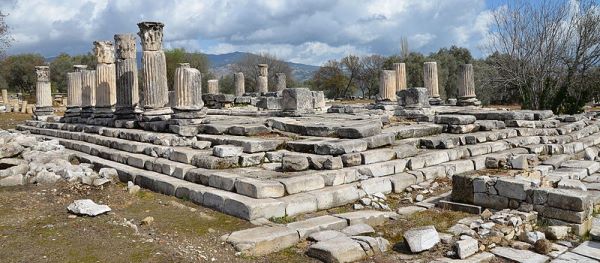Anatolia hosted many cult areas in ancient times. One of them was Lagina Hecate Sanctuary. The mysterious Goddess Hecate believed to hold the key to Hades, the lord of the dead and the home of the underworld, had an important place in Anatolian mythology. The word Hecate contains the meanings of ‘one who makes her will dominate’ and ‘the one who is far away, the brightest’. Hecate is very important in today’s modern paganism. The three witches seen in Shakespeare’s Macbeth are interpreted into the triple forms of Hecate.

Lagina Ancient City And The Temple of Hecate is of historical and touristic importance belonging to the Carian period and located in the Yatağan district of Muğla. Lagina Hecate sanctuary was the cult place of the ancient city of Stratonikeia and the religious center of the region. The ancient place, which is an important cult center of the Carians, is a settlement with an uninterrupted settlement from the ancient Bronze Age (3000 BC) to the present day where a little Turkish village is still can be visited. This is the only building built in the name of the goddess Hecate which can be visited today, and it is also of great archaeological importance as it is the second temple built in the Corinthian order in Anatolia.
Lagina Hecate Sanctuary has propylon (monumental entrance gate), sacred road, altar (sacrifice pit), peribolos (wall surrounding the sanctuary), Doric Stoas, and Hecate Temple. Archaeological excavations in the Lagina sanctuary are important since they are the first excavations carried out by Turkish scientists ever in Anatolia. Osman Hamdi Bey and Halit Ethem Bey conducted these excavations. Archaeological excavation and restoration works were resumed in 1993 under the leadership of the Muğla Museum, under the scientific consultancy of Turkish architects and archaeologists.
According to the Roman senate decision engraved on the wall of the Temple of Hecate and confirming the sacredness of the holy place, it is understood that the temple definitely existed in 81 BC. Although the exact construction date of the temple is not known, it is thought that it may belong to the end of the 2nd century BC and the beginning of the 1st century BC. Corinthian capitals contain features from the early 1st century BC and later. Although the decoration areas were planned when the temple was built, it is seen that some decorations continued until the Early Imperial Period and there are still unfinished parts. Studies on the architectural details, construction stages, and dating of the temple continue.
The processing of four different subjects on the friezes of the temple is a different practice seen in Hellenistic Period temples. The selection of topics was also very political. On the friezes of the Temple of Hecate; It is noteworthy that after the period of war and turmoil in the first half of the 2nd century BC, peace and friendship were sought to be brought to the fore.